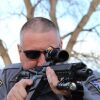I’ve known Lee Weems of First Person Safety and That Weems Guy podcast since 2016 but only in the past few years have I actually had a chance to spend some time getting to know him.
Lee is universally considered a top cop, an excellent trainer and a solid human being. I’m not just saying that because he is a former Okie or because of our completely justifiable, mutual affinity for Braum’s ice cream. As I have got to know him, I understand why people speak so highly of him. He is a gifted, intelligent instructor with a kindly southern demeanor. See his curriculum vitae here.
Naturally, when he invited several well-respected instructors – and me – to a beta class, I had to accept. A more than 800-mile drive would be worth attending the inaugural class simply dubbed “Instructor Camp.”
What makes this class different from other instructor classes?
I don’t know if this will be the case in all classes, but for this trial class, all invitees were Rangemaster Training Services Certified Instructors. Also, Weems has a way of figuring out what training gun folks actually need whether they know it or not. In this case, Lee wanted to teach instructors to marry individual coaching with running a line of shooters. He wanted to get instructors thinking about instructional design and the “why” of courses of fire.
Before class
As is the case with all top-shelf instructors, Lee emailed all the information we would need to attend the class and be successful weeks before the class. He provided information on where to stay and eat, etc. Weems also promised a special guest student who turned out to be Lynn Givens of Rangemaster Training Services.
During class
Naturally, each student instructor gave an introduction. It was expected to be two minutes. There was a pop question for each student. This two-in-one exercise not only helped us get to know each other; it got us on our toes for the rest of the class.
Among many other topics, we discussed the difference between interleaving and block/silo training in detail. We discussed various design models and which one works best in what situation. That said, it was a strictly enforced, doctrine-free zone. Discussion over the validity of specific techniques was discouraged. That is not the purpose of the class.
Practically speaking
We were charged with coming up with a designed instruction based on the model used by First Person Safety: Needs, Skills, Evaluation. Students could present individually or as a team. I did as I always did in high school when it came to projects that required smarts. I strategically sat near my super sharp instructor friends, Karen Whitlock of Trigger Time Indoor Range and Kari Grayson of License 2 Kari. They begrudgingly allowed me to ride their coattails. The rest of the class provided critiques and asked questions of the presenters. Learning occurred.
Live fire
Students were also required to run a course of fire. The rules were as follows:
- The course had to be sent to Weems for approval prior to the class.
- The student was required to choose an assistant instructor who would be briefed and assist with the line.
- All the shooters had to shoot together.
- The course of fire must have included shooting from at least two firing positions.
- The course of fire had to include a discussion of what the course of fire was supposed to accomplish.
- There was a 25-minute maximum.
- There was a 30-round maximum.
- Only principles, positions, etc., that were taught in Rangemaster Training Services Instructor classes could be included in the courses.
What I learned
For my course of fire, I modified the Oklahoma Peace Officer Qualification and made it a little spicier by cutting times and adding rounds. I called it the Okie Challenge. Part of the course is using a barricade at 25 yards from both the strong and support side hands. It’s a common part of cop qualifications and courses. However, when I had to explain it to Rangemaster Matriarch Lynn Givens, I knew I’d failed. You see, non-cops are rarely familiar with the concept of shooting from their support side from a barricade. I could hear Lee chuckling over the quiet confused chatter of my students as he watched that realization strike me.
Should you go to Instructor Camp?
- Do you know the difference between interleaving and block training?
- Do you know which is generally more effective and when to employ them?
- Are you familiar with the reverse chaining technique and why it’s so effective?
- Are you familiar with Bloom’s Taxonomy?
- Have you spent any time learning from Lee Weems?
If you can’t answer each of these questions with a resounding, “Yes,” you should seek out this or any of Lee’s classes. I promise you will come away a better instructor.
NEXT: Seconds save lives: A review of Ed Monk’s active shooter instructor class



